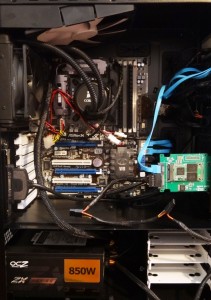 We have to apologize up front because our Test Bench is going through a bit of a transition but we thought it beneficial to throw in a picture in any case. A simple click will enlarge it to assist.
We have to apologize up front because our Test Bench is going through a bit of a transition but we thought it beneficial to throw in a picture in any case. A simple click will enlarge it to assist.
Our main goal in testing is to ensure that all test results are as accurate as they can be and no anomalies slip through.
We conduct all tests three times and, if necessary, we may conduct specific tests in Windows 7 safe mode to ensure the OS has little to no influence on the end result.
We prefer to use as many benchmark programs as possible to assist with confirmation of results and provide the reader with the actual tests as received to avoid any confusion when unexpected test benchmarks are received.
SSD COMPRESSION AND TESTING FLUCTUATIONS
All SSDs are not created equal and many new SSD enthusiasts realize that when they test their new drive to confirm specifications and ensure all is in order. SandForce controlled SSDs, as in the Renice x3 mSATA SSD we are testing today, use compression techniques in storage whereas many others do not. This creates a bit of confusion when enthusiasts test the drive with random data through benchmarking programs such as AS SSD and Crystal Diskmark (random data sample). The results seem to be lower than the listed specifications.
The results actually present a false portrayal of the drives ability when compared to other drives such as the Samsung PM800 mSATA and Intel 310 mSATA that we have reviewed previously. It is for this reason that all of our comparison testing is done through PCMark Vantage. PCMark Vantage HDD Suite simply provides evaluation results based on transfer speeds reached through typical user patterns. Vantage provides a better testing medium, in that, it sees through the typical synthetic benchmarks and provides us with true to life results of the drive.
BENCHMARK SOFTWARE
Software used for testing by The SSD Review consists of Crystal DiskMark, ATTO Benchmark, Anvil Storage Utilities along with FutureMark PCMark Vantage.
All do a great job of showing us the numbers that we want to see, or don’t want to see in some cases, while PCMark Vantage x64 is an excellent program which recreates tests that mimic the average users activity, all the while providing a medium to measure each.
ATTO DISK BENCHMARK VER. 2.46
ATTO Disk Benchmark is perhaps one of the oldest benchmarks going and is definitely the main staple for manufacturer performance specifications. ATTO uses RAW or compressible data and, for our benchmarks, we use a set length of 256mb and test both the read and write performance of various transfer sizes ranging from 0.5 to 8192kb. Manufacturers prefer this method of testing as it deals with raw (compressible) data rather than random (includes incompressible data) which, although more realistic, results in lower performance results.
 ATTO utilizes RAW or compressible data in their testing which is the most common used by manufacturers to determine their listed performance specifications. Specifications for the X3 are 260MB/s read and 200MB/s write however, as we can see here, we have done considerably better with 281MB/s read and 272MB/s write performance.
ATTO utilizes RAW or compressible data in their testing which is the most common used by manufacturers to determine their listed performance specifications. Specifications for the X3 are 260MB/s read and 200MB/s write however, as we can see here, we have done considerably better with 281MB/s read and 272MB/s write performance.
CRYSTAL DISK BENCHMARK VER. 3.0 X64
Crystal Disk Benchmark is used to measure read and write performance through sampling of raw (0/1 Fill/compressible) or random data which is, for the most part, incompressible. Many new SSD owners who can’t wait to test the performance of their SSD often grab this program and run a quick test, not realizing that they are testing with incompressible data rather than compressible data used in testing by manufacturers. The following results will show RAW data (oFill) on the left with random on the right.

 As we can see here, performance drops when incompressible is compared to RAW (or compressible) sample data. Through testing, we have learned that this is not really a large factor when considering a solid state drive for typical user activity. We can see by the results that the all important low 4k random write results remain consistent which is great as this accounts for the most visible performance upgrade one will see when examining all methods of disk access.
As we can see here, performance drops when incompressible is compared to RAW (or compressible) sample data. Through testing, we have learned that this is not really a large factor when considering a solid state drive for typical user activity. We can see by the results that the all important low 4k random write results remain consistent which is great as this accounts for the most visible performance upgrade one will see when examining all methods of disk access.
We can also see that the largest difference is attributable to high sequential and 512k disk access which would be something to be concerned with if you are transferring large amounts of incompressible files (movies/music/photos) on a frequent basis. As the common user might do this only once in migrating from a hard drive to a SSD though, they would never notice any difference whatsoever when considering an SSD on the basis if its incompressible data performance.
INDEX
Introduction to The X3 and Its Build
Test Protocol and Initial Testing
Anvil Pro and PCMark Vantage Testing
 The SSD Review The Worlds Dedicated SSD Education and Review Resource |
The SSD Review The Worlds Dedicated SSD Education and Review Resource | 